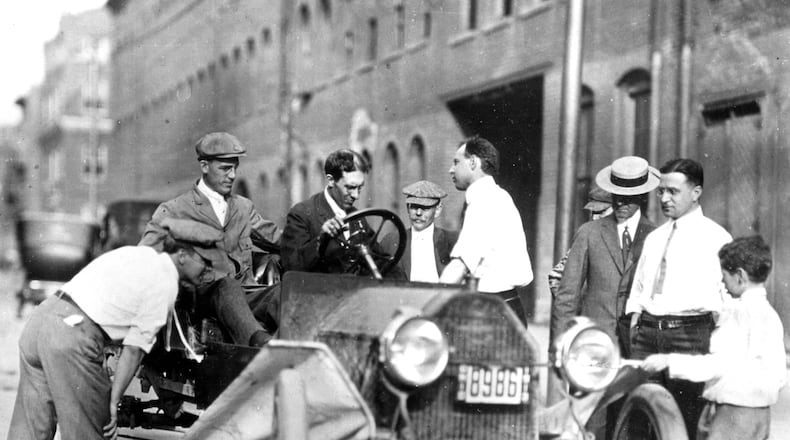While the Dayton area does not produce the number of patents it once did, innovation is well alive today with area inventors, researchers and companies.
Below are just some of the creators and their inventions from the Dayton area:
The Stepladder
Stepladders were invented by little known Daytonian John H. Balsey. A carpenter by trade, Balsey devised a wooden stepladder in 1865 in his shop on East First Street. The wonderfully logical invention was portable, suitable for any use and was patented on Feb. 8, 1870. Balsey later was granted patents in 1875 for an adjustable table leg and in 1876 for a paper bag machine, but throughout the 1870′s he concentrated on the manufacture and sale of the creation which earned him fame as “The Stepladder King.”
The Cash Register
James Ritty and John Birch first applied for a patent for their “CASH REGISTER AND INDICATOR” in 1879 after Ritty sought to find a way to keep his saloon employees from stealing.
The Airplane
Credit: John T. Daniels
Credit: John T. Daniels
The Wright brothers invented and flew the first airplane in 1903, recognized as “the first sustained and controlled heavier-than-air powered flight.”
The first “Engine Starting Device”
Credit: Cadillac Motor Car Division
Credit: Cadillac Motor Car Division
United States patent No. 1,150,523 revolutionized the automobile industry.
It was awarded to Dayton innovator Charles F. Kettering, whose invention, “engine starting device,” was patented on Aug. 17, 1915.
Kettering’s idea would save motorists from the often back-breaking and sometimes dangerous job of crank-starting their engines.
Back Pack Parachute
Floyd Smith was the designer of the first back pack parachute. On Mar. 28, 1919, the first jump from an airplane with the back pack parachute took place at McCook Field in Dayton Leslie Irving jumped from a DH-9 airplane flown by Floyd Smith.
Freon Coolant
In 1928, Thomas Midgley Jr. and Charles Kettering invented a “miracle compound” called Freon. Frigidaire received the first patent for the formula for CFCs on Dec. 31, 1928. Because Freon is non-toxic, it eliminated the danger posed by refrigerator leaks. Charles Kettering home is often referred to as the first home to have air conditioning.
Huffy RadioBike
The Huffy RadioBike was produced in 1955-56 by the Huffman Manufacturing Co. in Dayton. The bike had a waterproof and shockproof electron-tube radio in the tank with battery pack located on the back of the bike.
The Ice Cube Tray with quick release lever
On July 21, 1959, Arthur J. Frei and Raymond C. Davis received the patent for their innovation with the ice cube tray, described its purpose as a way to “minimize effort on the part of a housewife…”
The Pop Top
Ermal Fraze owned the Dayton Reliable Tool and Mfg. Co. when he invented the pull-top can, which replaced metal-top beverage cans that require a can opener. In 1977 Fraze modified his invention and patented the ‘push-in and fold back tab” to reduce litter and prevent cuts caused by the previous version.
The Bar Code
Paul McEnroe, a 1959 electrical engineering graduate of the University of Dayton, developed the bar code. Heading up a team of IBM researchers, McEnroe created a vertical-bar coding system and a laser code-scanner. The vertical coding UPC symbol system became an industry standard by the late 1970′s and is still used throughout the world.
LCD Display
John L. Janning, an employee at NCR, perfected the liquid crystal display (LCD). Janning’s oblique molecular alignment made it possible for the large scale manufacturing of LCDs in the early 1970s. LCDs took off quickly, appearing in watches and calculators before developing into uses for computer and TV screens, cell phones and more.
Cheez-Its
The Cheez-It was invented by the Green & Green Company in 1921, but its origin goes back even further. In 1847, Dr. William Wolf of Dayton determined his patients with dietary restrictions needed a different kind of food. To fill the need, Dr. Wolf created his own food, a hard butter cracker that became known as the Dayton Cracker. Dr. Wolf’s cracker became so popular it kicked off the growth of the cracker-baking industry in the city.
Trapper Keeper
In the late 1970s, Mead’s E. Bryant Crutchfield invented the Trapper Keeper, a binder with folders and pockets designed to hold school supplies. Its popularity grew throughout the 1980′s and 1990′s with over 75 million Trapper Keepers being sold.













